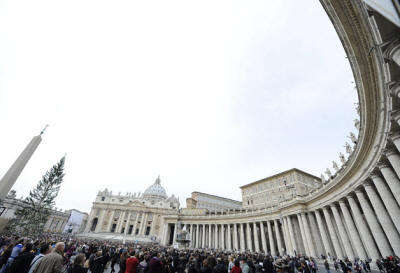|
|
|
by Victor Simpson and Nicole Winfield 19 December 2010 from Independent Website
St Peter's Square on
8 December during the Angelus noon prayer
Nevertheless, l'Istituto per le Opere
di Religione (the
Institute for Religious Works) is a
bank, and it is under harsh new scrutiny, including money-laundering
allegations that led police to seize €23m (£19.5m) in Vatican assets
in September. Critics say the case shows that the "Vatican Bank" has
never shed its penchant for secrecy and scandal.
But court documents show that prosecutors say the Vatican Bank deliberately flouted anti-laundering laws,
The documents also reveal investigators' suspicions that clergy may have acted as fronts for corrupt businessmen and the Mafia.
The documents pinpoint two transactions that have not been reported:
The new allegations of financial impropriety could not have come at a worse time for the Vatican, already hit by revelations that it sheltered pedophile priests.
The corruption probe has also given new hope to Holocaust survivors who tried unsuccessfully to sue the Vatican in the US, alleging that Nazi loot was stored in the bank. Yet the scandal is hardly the first for the centuries-old bank.
In 1986, a Vatican financial adviser died after drinking cyanide-laced coffee in prison.
Another was found dangling from a rope
under London's Blackfriars Bridge in 1982,
his pockets stuffed with money and stones. The incidents blackened
the bank's reputation, raised suspicions of ties with the Mafia, and
cost the Vatican hundreds of millions of dollars in legal clashes
with Italian authorities.
The bulk of the money, €20m, was
destined for the American JP Morgan's Frankfurt branch in Germany,
with the remainder going to Banca del Fucino, an Italian
bank. Prosecutors alleged the Vatican ignored regulations that
foreign banks must communicate to Italian financial authorities
where their money has come from. All banks have declined to comment.
Authorities say some €250,000, illegally
obtained from the regional government of Sicily for a fish-breeding
company, was sent to the priest by his father as a "charitable
donation", then sent back to Sicily from a Vatican Bank account
using a series of home-banking operations to make it difficult to
trace.
It said its investigation had found
"exactly the opposite".
However, in one of the 1980s scandals,
prosecutors could not arrest the then bank head Paul Marcinkus,
an American archbishop, because Italy's highest court ruled he had
immunity. Marcinkus, who died in 2006 and always proclaimed his
innocence, was the inspiration for Archbishop Gilday in Francis Ford
Coppola's The Godfather: Part III.
Gianluigi Nuzzi, author of Vatican SpA, a 2009 book outlining the bank's dealings, said it is possible the Vatican is serious about coming clean, but he is not optimistic.
He said the structure and culture of the institution is such that powerful account holders can exert pressure on management.
In addition, some managers are simply
resistant to change.
Mr Gotti Tedeschi has been on a public speaking tour extolling the benefits of a morality-based financial system.
It does not help that Mr Gotti Tedeschi himself and the bank's number two, Paolo Cipriani, are under investigation for alleged violations of money-laundering laws.
Both were questioned by Rome prosecutors
on 30 September, although no charges have been filed. In his
testimony, Mr Gotti Tedeschi said he knew little about the bank's
day-to-day operations, noting that he had been in the job less than
a year.
In a speech in October, he described a wider plot against the church, decrying,
As the Vatican proclaims its
innocence, the courts are holding firm. An Italian court has
rejected a Vatican appeal against the order to seize assets.
In another concession to modern times,
the bank recently began issuing credit cards.
After Sindona's banking empire collapsed in the mid-1970s, his links to the mob were exposed, sending him to prison in 1980 and his eventual death from poisoned coffee six years later. Calvi, who inherited his role, headed Banco Ambrosiano, which collapsed in 1982 after the disappearance of $1.3bn in loans made to dummy companies in Latin America.
The Vatican had provided letters of
credit for the loans.
After an initial ruling of suicide, murder charges were filed against five people, including a major Mafia figure, but all were acquitted after being tried. While denying wrongdoing, the Vatican Bank paid $250m to Ambrosiano's creditors.
Both the Calvi and Sindona cases remain unsolved.
|


